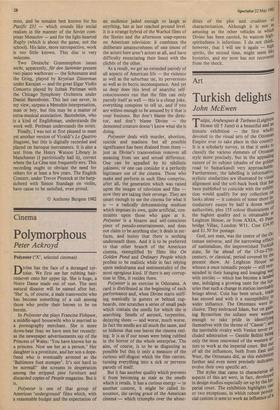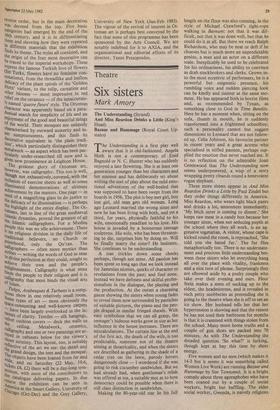Art
Turkish delights
John McEwen
Tulips, Arabesques & Turbans (Leighton House till 5 June) is a beautiful and an historic exhibition — the first wholly devoted to the visual arts of the Ottoman Empire ever to take place in this country. It is a scholarly survey, in that it seeks to classify the various elements of Ottoman style more precisely, but in the appealing nature of its subject (shades of the golden road to Samarkand) very approachable. Furthermore, the labelling is informative, stylistic similarities are illustrated by visual alignment and the soft-back book that has been published to coincide with the exhibi- tion would qualify for any collection on looks alone — it consists of some short in", troductory essays by half a dozen world authorities, plus 155 colour illustrations of the highest quality and is obtainable at Leighton House, or from AXIA, 43 Poll; bridge Villas, London WI 1. Cost £.14.9 and £1.50 for postage. God, not man, was the centre of the Ot- toman universe, and the narrowing effects of nationalism, the impoverished Turkish state, lie far ahead of the 15-to-17th- century, or classical, period covered by the present show. At Leighton House we witness a once nomadic people — still tent" minded in their hanging and lounging NO, with textiles — which has become a lancle° one, indulging a growing taste for the lux' uries that such a change in station inevitably brings about. Coin has been struck, trade has ensued and with it a susceptibility to wider influence. The Ottomans were in" elusive. They embraced Islam, but on On' ing Byzantium the sultans were western enough to take pride in identifying themselves with the throne of 'Caesar'; and the inevitable rivalry with Venice never ex- eluded admiration — Gentile Bellini being only the most renowned of the western art tists to work at the imperial court. But of all the influences, both from East an West, the Ottomans did, as this exhibition further and even more precisely indicates' evolve their own specific art. The styles that came to characterise all aspects of this art were, in fact, developed in design studios especially set up by the DTI: penal court. The exhibition highlights on
°
or two exceptions, in which robust provin- cial custom is seen to work an influence of a
reverse order, but in the main decoration was decreed from the top. Five basic categories had emerged by the end of the 16th century, and it is in differentiating them and showing how they were repeated in different materials that the exhibition finds its theme. The styles all coexisted, and the origin of the four most decorative can be traced to the imperial workshops. These express the famous Turkish love of flowers (for Turks, flowers have no feminine con- notations), from the threadlike and leafless delicacy of the plant spirals of the 'Golden Horn' variant, to the tulip, carnation and other blooms — most impressive in red relief on the ceramics — of the innaccurate- lY named 'quatre fleurs' style. The Ottoman character was apparently based on a para- doxical search for simplicity of life and an enjoyment of the good and beautiful things of the world. Their mosques are uniquely characterised by outward austerity and in- ner sumptuousness, and this finds its decorative equivalent in 'the plain tradi- tion, which particularly distinguishes their metalwork — an aspect which has been par- ticularly under-researched till now and is given new prominence at Leighton House. , The greatest glory of Ottoman art, nowever, was calligraphy. This too is well, Itinclusion not exhaustively,lcovered,; with the. ielUsion of exercise sheets as well as some illuminated demonstrations of ultimate achievement by the masters. One page — in the of a magnifying glass to do justice to the delicacy of its illumination — is perhaps the highlight of the entire display. The Ot- tomans, last in line of the great mediaeval „Ls'arnic dynasties, proved the greatest of all the Islamic calligraphers. For a Muslim People this was no idle achievement. There 3,s Ito religious division in the daily life of traditional believers, no Church or Priesthood, only the Qu'ran. The calligraphers — often more mystics than scribes writing the words of God as near t0 divine perfection as they could, sought to achieve their own and the people's bul, ightenment. Calligraphy is what most :lids the people to their religion and it is calligraphy that most binds the visual arts °Y Islam. t Tulips, Arabesques & Turbans is a sump- tuous show in one relatively small room. space- types of art — most obviously the 1pace-consuming and well-known carpets have been largely overlooked in the in- :rests of clarity. Textiles — silk hangings, theivet cushion covers — deck the walls to e ceiling. Metalwork, ceramics, calligraphy and one or two paintings are ar- i.Yed in cabinets below for the viewer's ;t0ser scrutiny. This layout, too, is suitably the grandof the art we see: the detail and grand design, the tent and the mosque. e objects have been loaned from far and tick Id, e, and on Saturday (22 May, 10-6, 13exets £4, £2) there will be a day-long sym- th:sium, with most of the contributors to ,.se catalogue delivering papers. In due course the exhibition can be seen in ,crica at the Smart Gallery, University of Chicago (Oct-Dec) and the Grey Gallery,
University of New York (Jan-Feb 1983). The vigour of the revival of interest in Ot- toman art is perhaps best conveyed by the fact that none of this programme has been sponsored by the Arts Council. We are notably indebted for it to AXIA, and the organisational and editorial efforts of its director, Yanni Petsopoulos.







































 Previous page
Previous page